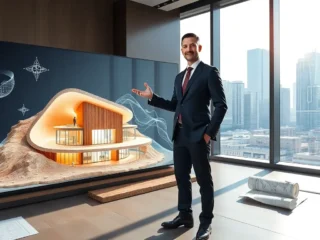
Realistic 3D interior rendering in architecture and real estate isn’t an option anymore. It’s the standard that helps industry professionals stay competitive in a digital-first landscape. With a detailed depiction of property that hasn’t been built yet, 3D visualization for interiors bridges the gap between sketches and reality, making it easier to sell concepts, secure approvals, and drive sales.
In this article, you’ll learn how 3D rendering for architecture changes the game and how to choose the right 3D interior rendering services provider for your needs.
3D Interior Rendering Explained
3D interior rendering is an interior CGI (computer-generated image) that represents what a space will look like once it’s fully built, furnished, and styled. Unlike 2D floor plans or technical blueprints, these images don’t just show layouts and dimensions. They convey the slightest detail of the future interior, including material textures, color palettes, and even how natural light fills a room at different times of day.
Why Rely on 3D Interior Renderings in the Sales Process
For architects and developers, photorealistic interior rendering has become an essential communication tool, especially when it comes to gaining buy-in, generating pre-sales, or securing planning approvals. When your project exists only on paper, a high-quality real estate CGI can make it feel tangible and worth investing in. Here’s what you can achieve with interior renderings.
Aligned vision between architects and clients
One of the biggest challenges in architecture and design is making sure everyone shares the same vision. Clients often struggle to interpret floor plans or technical drawings, leading to misaligned expectations and costly revisions.
This is where client-ready visuals come in handy. Thanks to the photorealistic depiction of the end result, interior design rendering helps you build trust, speed up approvals, and reduce the risk of misunderstandings during the construction process.
Developer confidence and pre-sale marketing
Developers and real estate professionals increasingly turn to high-quality 3D interior renders to market properties at the early construction stages. They serve as a powerful tool for showcasing design intent on websites, in brochures, across social media, or during investor presentations.
By presenting a photorealistic view of a future space, pre-sale design visualization helps developers build an emotional connection with their buyers and secure investments for their project early on.
Cost-effective design adjustments
Making changes during construction can be time-consuming and expensive. Architectural interior visualization allows you to experiment with different design options digitally, adjusting layouts, materials, color schemes, or lighting without any physical work. This flexibility saves time, reduces material waste, and enables better-informed design decisions.
Staying competitive in a digital-first industry
Today’s clients expect to be wowed by polished presentations, and the real estate industry isn’t an exception. Developers and architecture firms that invest in pitch-ready interior visuals position themselves as modern, tech-savvy, and client-focused.
By offering lifelike visualizations from the start, you demonstrate both professionalism and attention to detail. These visuals not only impress potential buyers and investors but also help your project stand out in a crowded market.
What to Look For in Interior Rendering Services
Not all architectural visualizations are created equal. If you want your project to shine, you need a rendering partner who can deliver both quality and consistency. Here are the key things to consider when choosing among interior rendering services.
Portfolio quality
The portfolio is the first thing to look at when choosing a 3D interior rendering provider.

The images should feel realistic and well thought-out, with natural lighting, detailed textures, and a clear sense of atmosphere. A strong portfolio shows that the team knows how to bring spaces to life and create visuals that people can instantly connect with.
Industry relevance
Look for a team that has experience with your type of project, whether it’s high-end residential, commercial office space, hospitality, or mixed-use development. Each sector has its nuances, and working with an architectural visualization provider who understands your industry can save time and meet expected results.
Communication and responsiveness
Good communication makes the whole process easier. It helps when the team is easy to talk to, understands your goals, and stays open to feedback along the way. The best rendering partners feel like part of your team — they get your vision and know how to turn it into clear, compelling images.
Revision flexibility
3D interior rendering is rarely perfect on the first try, especially if you haven’t worked with a particular visualization company before. A professional provider should include revision rounds in their process and be open to fine-tuning details like furniture, lighting, or color schemes. This flexibility ensures the final result aligns with your expectations.
Conclusion
In today’s competitive real estate and architecture markets, visuals can make or break a deal. That’s why more professionals are turning to high-quality interior rendering services to bring their ideas to life. Whether you’re refining a concept, pitching to investors, or preparing developer marketing materials, realistic 3D visuals are no longer a bonus; they’re expected.
Used as powerful design presentation tools, interior renderings help align teams, impress clients, and speed up decision-making. And the right rendering partner helps you present your space in a way that feels real, memorable, and easy to emotionally connect with.












